Best Tree for Privacy
- December 19, 2023
- 0 comment
Privacy in one’s own backyard is a cherished aspect of home life, and trees are one of the most natural and aesthetically pleasing ways to achieve it. Not only do they provide a shield from prying eyes, but they also contribute to the local ecosystem, offering habitats for wildlife and improving air quality. This article delves into the best trees for privacy, considering various factors like growth rate, maintenance, and climatic suitability.
Top Trees for Privacy
1. Arborvitae (Thuja)
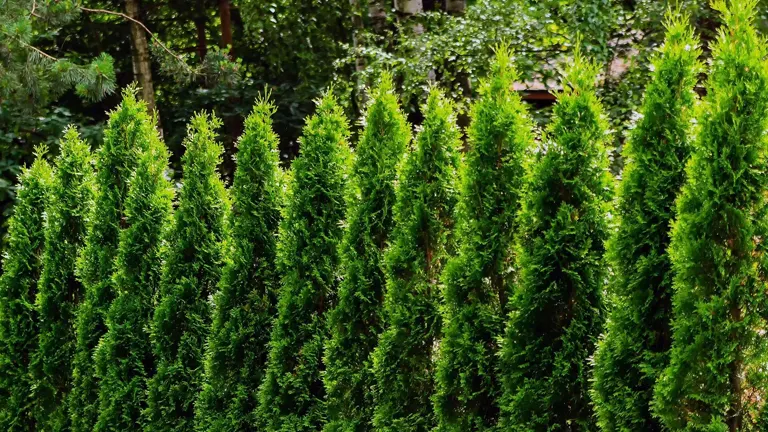
The Arborvitae, particularly varieties like ‘Emerald Green’ and ‘Green Giant’, are widely chosen for their dense foliage, making them excellent for privacy screens. These trees are known for their moderate growth rate, typically growing 3-4 feet per year, and can reach heights of 12-14 feet. They thrive best in well-drained soil and require full to partial sun exposure. Their columnar shape makes them a popular choice for creating natural fences.
2. Leyland Cypress

The Leyland Cypress is another favorite for privacy due to its rapid growth rate, often growing 3-4 feet per year and its thick foliage. For optimal growth, these trees need full sun and regular watering, especially during dry periods. When planting Leyland Cypress for a privacy screen, space them about 6 feet apart to ensure a dense, effective barrier.
3. Bamboo (Fargesia and Phyllostachys)
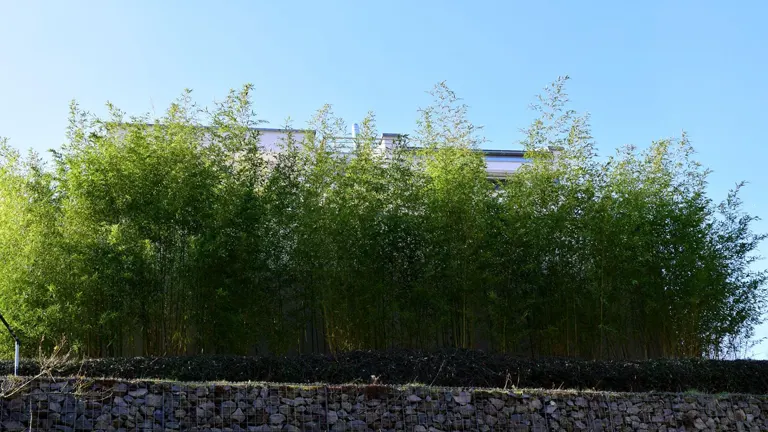
Bamboo is unique in its aesthetic and is a fast-growing option, with some species growing 1-4 feet per year. Clumping varieties, such as Fargesia, are generally preferred for privacy screens as they are less invasive than running types like Phyllostachys. Bamboo plants do best in full sun to partial shade and require regular watering to maintain their lush appearance.
4. Holly (Ilex)

Holly trees, with varieties like ‘Nellie R. Stevens’, are known for their dense foliage and attractive berries. They grow at a rate of 2-3 feet per year and can reach heights between 15-30 feet. Holly trees are adaptable but prefer well-drained soil and full to partial sun exposure. Their glossy leaves and seasonal berries add an aesthetic appeal to privacy landscaping.
5. Ficus (Ficus benjamin)

Particularly suitable for warmer climates, the Ficus benjamina can grow 2-3 feet per year and may reach heights of 25-30 feet, providing extensive privacy coverage. These trees prefer a sunny spot but can tolerate partial shade. Regular watering and occasional pruning help maintain their shape and health, making them a versatile choice for privacy screens in warmer regions.
The Ecological Benefits of Using Trees for Privacy
Utilizing trees for privacy in your garden or property doesn’t just create a secluded and tranquil space; it also offers considerable ecological advantages. These benefits extend far beyond the confines of your yard, contributing positively to the broader environment.
- Trees are vital in providing natural habitats for various species of birds, insects, and small mammals. By planting trees, you create a micro-ecosystem where wildlife can thrive. This biodiversity is crucial for maintaining ecological balance and supports the health of local ecosystems.
- Trees are natural air purifiers. Through the process of photosynthesis, they absorb carbon dioxide, a major greenhouse gas, and release oxygen back into the air. This exchange is essential for improving air quality, making trees a natural solution for mitigating pollution in urban and suburban areas.
- Trees play a critical role in carbon sequestration, capturing atmospheric carbon in their wood, leaves, and roots. By planting trees for privacy, you are actively contributing to the reduction of the overall carbon footprint. Over their lifespan, trees can absorb significant amounts of carbon dioxide, helping to combat climate change.
- Trees provide shade, which can significantly lower temperatures in their immediate surroundings. This natural cooling effect is particularly beneficial in urban areas, where concrete and asphalt surfaces tend to increase temperatures. By reducing the heat island effect, trees contribute to a more pleasant and sustainable living environment.
- Trees help in maintaining soil health by reducing erosion. Their roots hold the soil in place, while their canopy lessens the impact of raindrops on the soil surface. This is particularly important in areas prone to heavy rains or where soil erosion is a concern.
- Trees play a crucial role in the water cycle. They absorb water from the soil and release it into the atmosphere through transpiration, contributing to cloud formation and precipitation. This process is essential for maintaining local and regional water cycles.
Factors to Consider When Choosing Privacy Trees
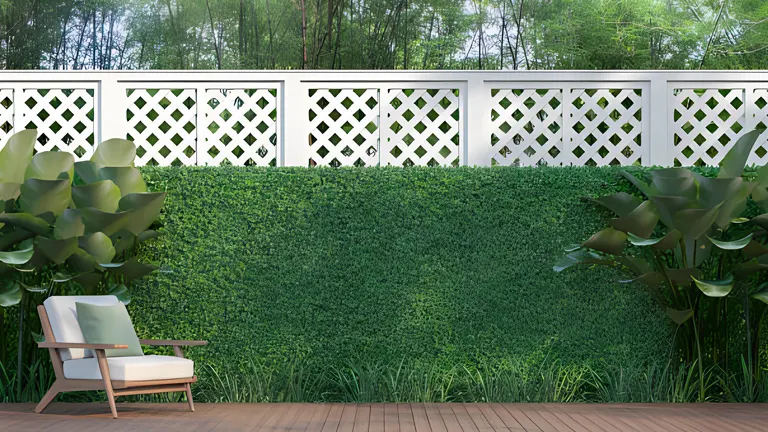
Selecting the right trees for privacy is a critical decision that can enhance the beauty, value, and enjoyment of your property. However, it’s not just about picking the tallest or fastest-growing trees. Several key factors need to be considered to ensure that you choose trees that are not only effective for privacy but also suitable for your specific environment and lifestyle. Here’s what to keep in mind:
Climate and Hardiness Zone
- The success of any tree largely depends on how well it adapts to your local climate.
- Each tree species has specific requirements in terms of temperature, humidity, and rainfall.
- The USDA Hardiness Zone Map is an essential tool that provides critical information about which trees will thrive in your specific area.
- Understanding your zone helps you avoid planting trees that won’t survive your local winters or that might struggle during hot summers.
Space and Growth Rate
- It’s important to consider both the horizontal and vertical space available in your yard.
- Fast-growing trees like the Hybrid Poplar or Leyland Cypress can provide quick privacy, but they also require more space and can become overwhelming in smaller yards.
- Remember, some trees have invasive root systems that can disrupt foundations, sidewalks, and septic systems.
- Additionally, fast growth often equates to more maintenance and a shorter lifespan, so balance your need for immediate privacy with long-term considerations.
Maintenance
- Different tree species require varying levels of care.
- Some trees, like the Oak or Maple, might need occasional pruning to maintain shape and health.
- Others, such as certain types of Pine or Spruce, are relatively low maintenance but might require regular cleaning up of needles or cones.
- Consider your willingness to invest time and resources into maintenance tasks like pruning, raking leaves, or managing pests and diseases.
Evergreen vs. Deciduous
- This choice depends on your preference for year-round versus seasonal privacy.
- Evergreen trees, such as Arborvitae or Holly, keep their foliage throughout the year, offering consistent privacy.
- Deciduous trees, like Birch or certain Maples, provide a thick canopy of leaves in the spring and summer but lose their leaves in the fall, offering less privacy in winter.
- Deciduous trees, however, can offer other benefits like beautiful autumn foliage and allowing sunlight through in the winter months.
The choice of privacy trees should be a thoughtful process, taking into account your specific local conditions and personal preferences. Whether you prioritize rapid growth, low maintenance, or year-round privacy, there’s a tree species that can meet your needs. Consulting with local nurseries or landscaping professionals can also provide valuable insights tailored to your specific environment.
Additional Tips for Creating a Privacy Screen with Trees
Creating a privacy screen with trees involves more than just selecting the right species. A well-thought-out approach can enhance the effectiveness and aesthetic appeal of your privacy screen. Here are some additional tips to consider:
Mastering Layers and Spacing in Your Garden
When planning a privacy screen with trees, adopting a layered planting approach while being mindful of size and spacing can yield both aesthetic beauty and functional effectiveness. Start by assessing the area for planting, considering the mature height and width of different tree species to ensure they fit comfortably without overcrowding.
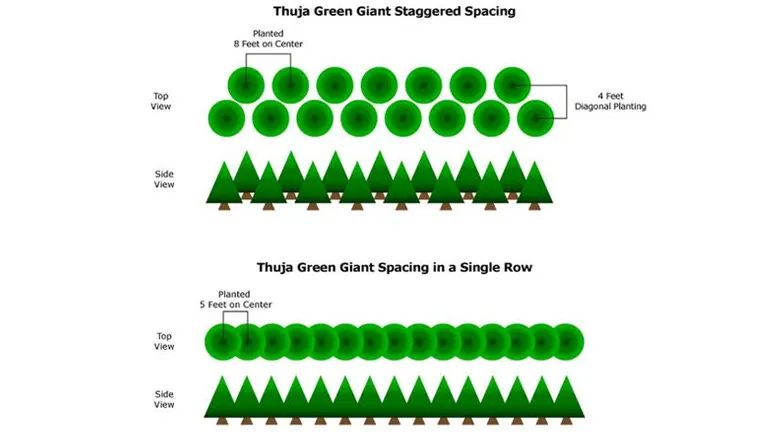
Plant taller trees, such as evergreens or large deciduous species, as the primary backdrop, ensuring they are placed at least 10 to 15 feet away from your home or other structures to accommodate their growth and protect your property. Mid-height trees or large shrubs can then be added in front of these, with smaller shrubs and perennials in the foreground, creating a tiered effect that adds depth and visual interest. This staggered arrangement not only enhances the garden’s aesthetics but also ensures continuous privacy, even as lower branches of the taller trees mature and thin out. Additionally, when planting, maintain a distance of about 4 to 5 feet from patios, fences, and other structures, and be conscious of utility lines by selecting shorter trees in these areas. Proper spacing, considering the trees’ crown width and root systems, is crucial; generally, planting trees 12 to 24 inches apart from their centers is effective, though this can vary based on the tree type and growth rate. Such thoughtful planning in the layout and spacing of your privacy trees will provide an effective screen while ensuring healthy growth and sustainability.
Incorporating Shrubs and Perennials

To further enhance your privacy screen, consider planting shrubs and perennials at the base of your trees. This not only adds an extra layer of privacy but also brings in color, texture, and variety to your garden. Shrubs like Boxwood or Privet can create a dense, low hedge, while flowering perennials can add seasonal interest. This method also aids in creating a habitat-friendly environment, attracting birds and beneficial insects to your garden.
Legal Considerations
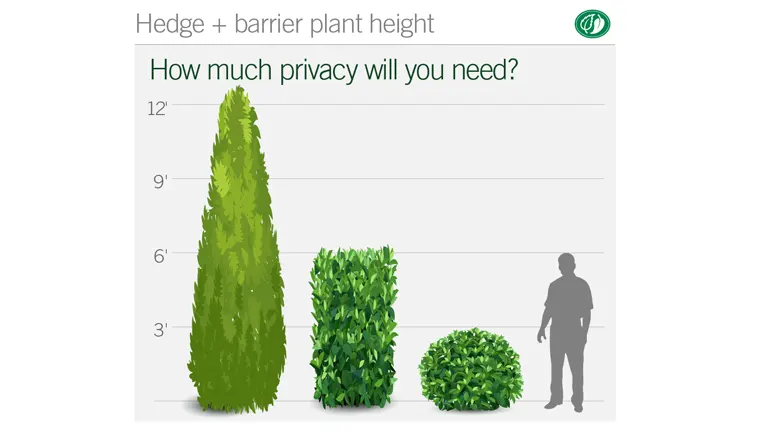
Before embarking on planting, it’s crucial to be aware of any local zoning laws, property line restrictions, and neighborhood regulations regarding tree planting. Some areas may have specific rules about the height of plantings, the types of species allowed, or how close trees can be to property lines or public pathways. Consulting with local authorities or a legal advisor can prevent potential legal issues and ensure that your privacy screen doesn’t become a source of conflict with neighbors or the community.
What Can I Plant to Block the Neighbors View
When looking to block a neighbor’s view for more privacy, there are several options ranging from trees and shrubs to climbing plants and hedges. The choice depends on the space available, how quickly you need privacy, and the maintenance you’re willing to undertake. Here’s a guide on what you can plant:
- For quick privacy, Leyland Cypress is an excellent choice due to its rapid growth and dense foliage. The Arborvitae, particularly the ‘Green Giant’ variety, is also popular for creating tall privacy screens. Another option is the Hybrid Poplar, one of the fastest-growing trees, perfect for immediate screening.
- Boxwood shrubs are versatile, as they can be trimmed to the desired height and shape, forming a dense barrier. Laurel shrubs, including Cherry Laurel and English Laurel, are known for their thick, lush leaves. Photinia, especially the Red Robin variety, is attractive for its young red leaves that turn green with maturity.
- For a lighter and more aesthetic touch, Birch trees offer a pleasing look while providing some privacy. Dogwood shrubs are another option, offering thick foliage in the summer and beautiful flowers.
- Ivy is a dense, evergreen option that’s perfect for covering walls or fences. Clematis adds beauty with its lovely flowers but requires a structure to climb. Wisteria, known for its stunning flowers and thick foliage, grows more slowly but is worth the wait.
- Privet is a fast-growing hedge that can be easily shaped. Hawthorn is another dense option suitable for various soil types. Holly not only provides privacy but also adds aesthetic appeal with its berries.
- For a more exotic look, clumping bamboo like Fargesia creates a dense screen without taking over the garden.
- Tall varieties, such as Miscanthus, offer a softer, less formal privacy barrier.
- Combining different types of plants, including trees, shrubs, and perennials, can create a more natural and attractive barrier.
Pruning Privacy Trees
Pruning privacy trees effectively is key to maintaining their health and shape, but it’s important to approach this task with knowledge and care to avoid permanent damage. For newly planted trees, minimal pruning is recommended; focus primarily on removing dead or diseased branches. Excessive pruning at this stage can cause undue stress and impact the tree’s development. When pruning, always make cuts outside the branch collar the swollen area where the branch meets the trunk to avoid harming the tree’s vital trunk area, as damage here can lead to internal decay.
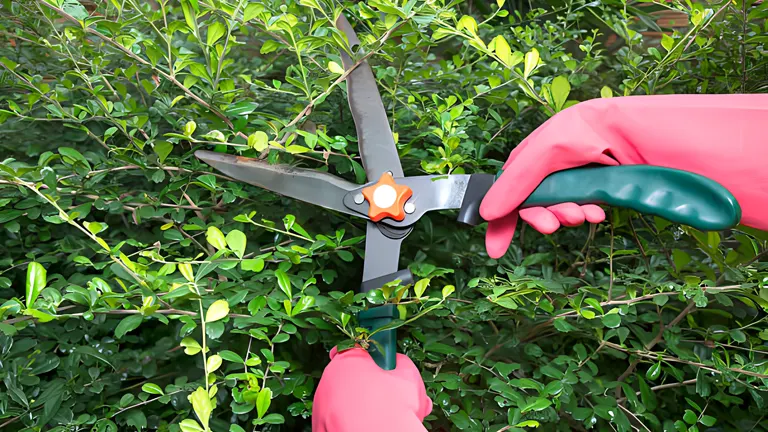
Smaller branches are generally easier and safer to prune. If you need to remove a larger branch, it’s best to prune back to a secondary branch or bud, ensuring the cuts are precise and clean to prevent any decay. It’s crucial to avoid cutting the dominant leader stem of young trees, especially the tip, as this is central to their upward growth. In cases where a tree develops double leaders or co-dominant stems, it may be necessary to prune one to avoid structural weakness later on. Most importantly, remember that over-pruning, particularly in young trees, can be detrimental. The tree’s canopy plays a crucial role in food production and storage, and excessive removal of branches can lead to growth and health issues. Therefore, while pruning is an essential part of tree maintenance, it should be done thoughtfully and judiciously to ensure the tree’s long-term health and effectiveness as a privacy screen.
Conclusion
Choosing the right trees for privacy enhances the beauty and tranquility of your space while contributing positively to the environment. Consider your local ecosystem, space, and personal preferences when selecting trees to ensure they thrive and meet your privacy needs.
Related Articles:
- Best Trees for Front Yard
- Best Small Trees for Your Front Yard
- Best Evergreen Trees for Privacy
- Best Trees for Indoors
FAQs
- Can privacy trees also support local wildlife?
Absolutely! Many privacy trees, especially native species, can offer crucial habitats for birds, beneficial insects, and small mammals. Trees with berries or flowers, like Hollies or certain Dogwoods, are particularly valuable for wildlife. - How can I ensure my privacy trees are eco-friendly?
Opt for native species as they’re adapted to your local environment, require less water, and support local ecosystems. Also, consider organic gardening practices, such as avoiding chemical fertilizers and pesticides. - What are some fast-growing privacy trees that are also drought-resistant?
Species like the Thuja Green Giant and certain types of Cypress are known for both rapid growth and drought resistance, making them ideal for privacy without needing excessive watering. - Can I use fruit trees for privacy?
Yes, fruit trees like Citrus, Apple, or Pear trees can provide privacy and the added benefit of producing fruit. Just be mindful of their mature size and maintenance needs. - How do privacy trees affect property value?
Well-placed privacy trees can enhance curb appeal and property value. They provide aesthetic beauty, reduce noise pollution, and can even lower energy costs by providing shade. - Are there privacy trees suitable for small urban yards?
Certainly! Columnar or fastigiate tree varieties, like the Italian Cypress or certain Junipers, grow upwards rather than outwards, making them perfect for tight spaces. - Can climbing plants on trellises replace trees for privacy in limited spaces?
Yes, climbers like Ivy, Clematis, or Wisteria on trellises or fences are excellent for creating privacy in smaller gardens where planting large trees isn’t feasible. - How do privacy trees impact local ecosystems compared to fences or walls?
Unlike man-made barriers, trees contribute to local ecosystems by improving air quality, supporting wildlife, and maintaining natural water cycles. They offer a living, eco-friendly alternative to fences or walls. - What’s the best way to maintain privacy trees in different seasons?
Regular pruning is key, especially for deciduous trees. For evergreens, minimal maintenance is required, but seasonal check-ups for health issues or structural problems are beneficial. - Can I plant privacy trees close to my house without risking foundation damage?
It’s essential to choose trees with non-invasive root systems for planting near structures. Consult with a local arborist or nursery for species that are safe to plant close to buildings.

David Murray
Forestry AuthorI'm David Murry, a forestry equipment specialist with a focus on chainsaw operation. With over 13 years of experience, I've honed my skills in operating and maintaining a wide range of machinery, from chainsaws to log splitters. My passion for the outdoors and commitment to sustainable forestry drive my work, which emphasizes safety, efficiency, and staying updated with industry advancements. Additionally, I'm dedicated to sharing my expertise and promoting environmental awareness within the forestry community.










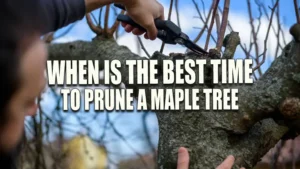


Leave your comment